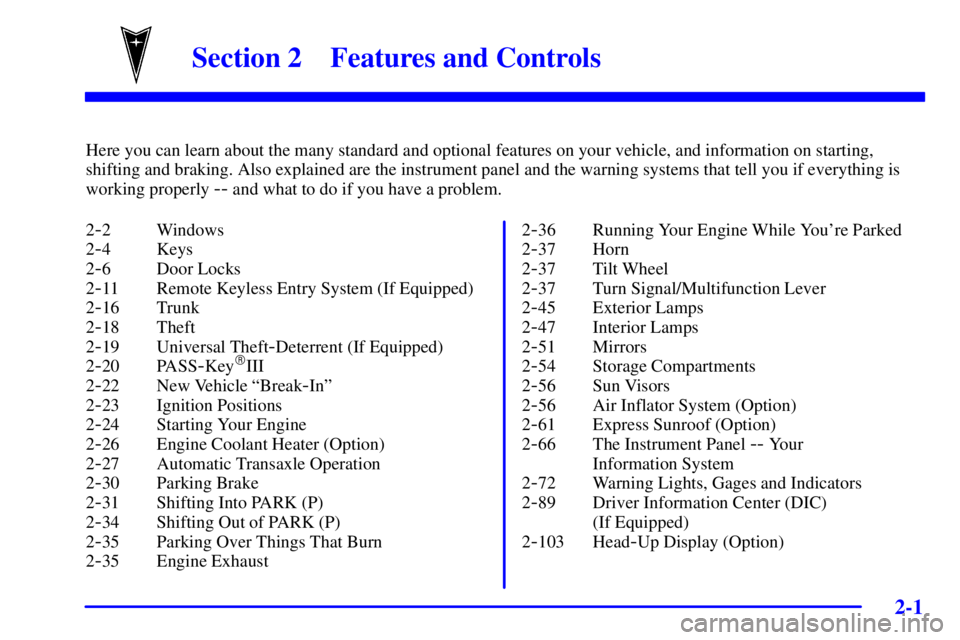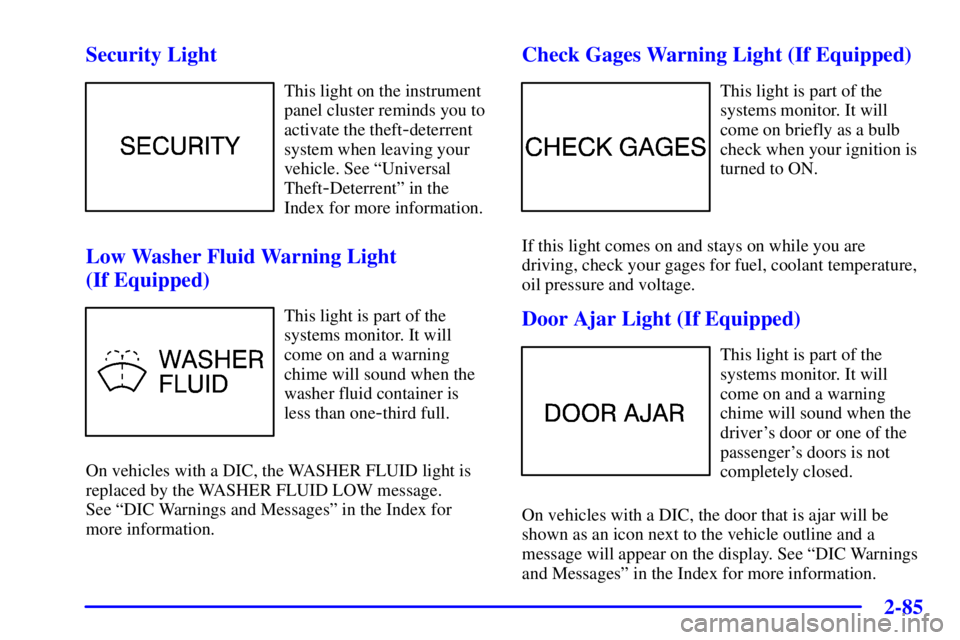Page 11 of 413

ix
For example,
these symbols
are used on an
original battery:
CAUTION
POSSIBLE
INJURY
PROTECT
EYES BY
SHIELDING
CAUSTIC
BATTERY
ACID COULD
CAUSE
BURNS
AVOID
SPARKS OR
FLAMES
SPARK OR
FLAME
COULD
EXPLODE
BATTERY
These symbols
are important for
you and your
passengers
whenever your
vehicle is driven:
CHILD
RESTRAINT
TOP STRAP
ANCHOR
DOOR LOCK
UNLOCK
FASTEN
SEAT
BELTS
POWER
WINDOW
AIR BAG
These symbols
have to do with
your lamps:
MASTER
LIGHTING
SWITCH
TURN
SIGNALS
PARKING
LAMPS
HAZARD
WARNING
FLASHER
DAYTIME
RUNNING
LAMPS
FOG LAMPS
These symbols
are on some of
your controls:
WINDSHIELD
WIPER
WINDSHIELD
WASHER
WINDSHIELD
DEFROSTER
REAR
WINDOW
DEFOGGER
VENTILATING
FAN
These symbols
are used on
warning and
indicator lights:
ENGINE
COOLANT
TEMP
BATTERY
CHARGING
SYSTEM
BRAKE
COOLANT
ENGINE OIL
PRESSURE
ANTI-LOCK
BRAKES
Here are some
other symbols
you may see:
FUSE
LIGHTER
HORN
FUEL
Vehicle Symbols
These are some of the symbols you may find on your vehicle. Also see ªWarning Lights and Gagesº in the Index.
Page 68 of 413

2-
2-1
Section 2 Features and Controls
Here you can learn about the many standard and optional features on your vehicle, and information on starting,
shifting and braking. Also explained are the instrument panel and the warning systems that tell you if everything is
working properly
-- and what to do if you have a problem.
2
-2 Windows
2
-4 Keys
2
-6 Door Locks
2
-11 Remote Keyless Entry System (If Equipped)
2
-16 Trunk
2
-18 Theft
2
-19 Universal Theft-Deterrent (If Equipped)
2
-20 PASS-Key�III
2
-22 New Vehicle ªBreak-Inº
2
-23 Ignition Positions
2
-24 Starting Your Engine
2
-26 Engine Coolant Heater (Option)
2
-27 Automatic Transaxle Operation
2
-30 Parking Brake
2
-31 Shifting Into PARK (P)
2
-34 Shifting Out of PARK (P)
2
-35 Parking Over Things That Burn
2
-35 Engine Exhaust2
-36 Running Your Engine While You're Parked
2
-37 Horn
2
-37 Tilt Wheel
2
-37 Turn Signal/Multifunction Lever
2
-45 Exterior Lamps
2
-47 Interior Lamps
2
-51 Mirrors
2
-54 Storage Compartments
2
-56 Sun Visors
2
-56 Air Inflator System (Option)
2
-61 Express Sunroof (Option)
2
-66 The Instrument Panel -- Your
Information System
2
-72 Warning Lights, Gages and Indicators
2
-89 Driver Information Center (DIC)
(If Equipped)
2
-103 Head-Up Display (Option)
Page 93 of 413

2-26
Engine Coolant Heater (Option)
In very cold weather, 0�F (-18�C) or colder, the engine
coolant heater can help. You'll get easier starting and
better fuel economy during engine warm
-up. Usually,
the coolant heater should be plugged in a minimum of
four hours prior to starting your vehicle.
To Use the Engine Coolant Heater
1. Turn off the engine.
2. Open the hood and unwrap the electrical cord.
The engine coolant heater cord is located on
the passenger's side of the vehicle, above the
headlamp assembly.
3. Plug it into a normal, grounded 110
-volt AC outlet.
CAUTION:
Plugging the cord into an ungrounded outlet
could cause an electrical shock. Also, the wrong
kind of extension cord could overheat and cause
a fire. You could be seriously injured. Plug the
cord into a properly grounded three
-prong
11 0
-volt AC outlet. If the cord won't reach, use a
heavy
-duty three-prong extension cord rated for
at least 15 amps.
4. Before starting the engine, be sure to unplug and store
the cord as it was before to keep it away from moving
engine parts. If you don't, it could be damaged.
How long should you keep the coolant heater plugged
in? The answer depends on the outside temperature, the
kind of oil you have, and some other things. Instead of
trying to list everything here, we ask that you contact
your dealer in the area where you'll be parking your
vehicle. The dealer can give you the best advice for that
particular area.
Page 145 of 413

2-78
Low Traction Active (LOW TRAC) Light
Your LOW TRAC
(Low Traction Active) light
may come on for one of the
following reasons:
�An advanced computer
-controlled system called
Stabilitrak� (if equipped) has come on to help your
vehicle continue to go in the direction in which
you're steering. This stability enhancement system
activates when the computer senses that your vehicle
is just starting to spin, as it might if you hit a patch
of ice or other slippery spot on the road. When the
system is on, you may hear a noise or feel a vibration
in the brake pedal. This is normal.
In these situations when the LOW TRAC light is on
and the system is engaged, you should continue to
steer in the direction you want to go. The system is
designed to help you in bad weather or other difficult
driving situations by making the most of whatever
road conditions will permit.�The optional Traction Control System is active
and is limiting wheel spin. You may feel the system
working, but this is normal. Slippery road conditions
may exist, so adjust your driving accordingly.
If the LOW TRAC light comes on, slippery road
conditions may exist, so you should consider slowing
down and adjusting your driving accordingly.
Engine Coolant Temperature Gage
United States Canada
This gage shows the engine coolant temperature.
Page 152 of 413

2-85 Security Light
This light on the instrument
panel cluster reminds you to
activate the theft
-deterrent
system when leaving your
vehicle. See ªUniversal
Theft
-Deterrentº in the
Index for more information.
Low Washer Fluid Warning Light
(If Equipped)
This light is part of the
systems monitor. It will
come on and a warning
chime will sound when the
washer fluid container is
less than one
-third full.
On vehicles with a DIC, the WASHER FLUID light is
replaced by the WASHER FLUID LOW message.
See ªDIC Warnings and Messagesº in the Index for
more information.
Check Gages Warning Light (If Equipped)
This light is part of the
systems monitor. It will
come on briefly as a bulb
check when your ignition is
turned to ON.
If this light comes on and stays on while you are
driving, check your gages for fuel, coolant temperature,
oil pressure and voltage.
Door Ajar Light (If Equipped)
This light is part of the
systems monitor. It will
come on and a warning
chime will sound when the
driver's door or one of the
passenger's doors is not
completely closed.
On vehicles with a DIC, the door that is ajar will be
shown as an icon next to the vehicle outline and a
message will appear on the display. See ªDIC Warnings
and Messagesº in the Index for more information.
Page 170 of 413
2-103
Head-Up Display (Option)
CAUTION:
If the HUD image is too bright, or too high in
your field of view, it may take you more time to
see things you need to see when it's dark outside.
Be sure to keep the HUD image dim and placed
low in your field of view.
If you have the optional Head-Up Display (HUD), you
can see some of the driver information also available on
your instrument panel cluster. The information may be
displayed in English or metric units and appears as
a reflection on the windshield. The HUD shows
the following:
�Speedometer Reading
�Turn Signal Indicators
�High
-beam Indicator Symbol
�CHECK GAGES Message (for low oil pressure,
high coolant temperature, low oil level, high/low
battery, brake, ABS and air bag.)
�Low Fuel Warning Symbol
�Radio Frequency and Playback Mode
Page 179 of 413

3-6
Automatic Operation
When the system is set for AUTO, your climate control
system will control the air delivery mode, fan speed, A/C
and RECIRC operations. Air will come from the floor,
panel or windshield outlets. The fan speed will vary as the
system maintains the selected temperature setting.
When AUTO is selected, the A/C operation and air inlet
will be automatically controlled. The air conditioning
compressor will run at outside temperatures over
approximately 40�F (4�C). The air inlet will normally
be set to outside air. If it's hot outside, the air inlet will
automatically switch to recirculated inside air to help
quickly cool down your vehicle.
To find your comfort zone, start with 75� F (24�C)
temperature setting and allow about 20 minutes for the
system to regulate. Turn the TEMP knob up or down to
adjust the temperature setting if necessary. If you choose
the temperature setting of 60�F (15�C), the system will
remain at the maximum cooling setting and fan speed. If
you choose the temperature setting of 90�F (33�C), the
system will remain at the maximum heat setting and fan
speed. Choosing either maximum setting will not cause
the system to heat or cool any faster.Be careful not to cover the sensor located on the top of
the instrument panel near the windshield. This sensor
regulates temperature based on sun load.
The EXT (exterior) temperature sensor is located in
the front of the vehicle behind the grille. The displayed
temperature is most accurate after the vehicle has been
moving for a few minutes. If the vehicle is stopped and
then restarted within 2 1/2 hours, the sensor will be hot
from the engine heat. In this case, the temperature first
displayed will continue to be the previous temperature.
The display will update after the vehicle has been
moving for a few minutes and the sensor has a chance
to cool down to the actual temperature.
To avoid blowing cold air in cold weather, the system
will delay turning on the fan until warm air is available.
The length of delay depends on engine coolant
temperature. Pushing the fan button will override
this delay and change the fan to a selected speed.
Page 264 of 413
5-9
Engine Overheating
You will find a coolant temperature gage or a DIC
warning message about a hot engine on your vehicle's
instrument panel. See ªCoolant Temperature Gageº and
ªDIC Warnings and Messagesº in the Index.
If Steam Is Coming From Your Engine
CAUTION:
Steam from an overheated engine can burn you
badly, even if you just open the hood. Stay away
from the engine if you see or hear steam coming
from it. Just turn it off and get everyone away
from the vehicle until it cools down. Wait until
there is no sign of steam or coolant before you
open the hood.
If you keep driving when your engine is
overheated, the liquids in it can catch fire. You or
others could be badly burned. Stop your engine if
it overheats, and get out of the vehicle until the
engine is cool.
NOTICE:
If your engine catches fire because you keep
driving with no coolant, your vehicle can be
badly damaged. The costly repairs would not be
covered by your warranty.